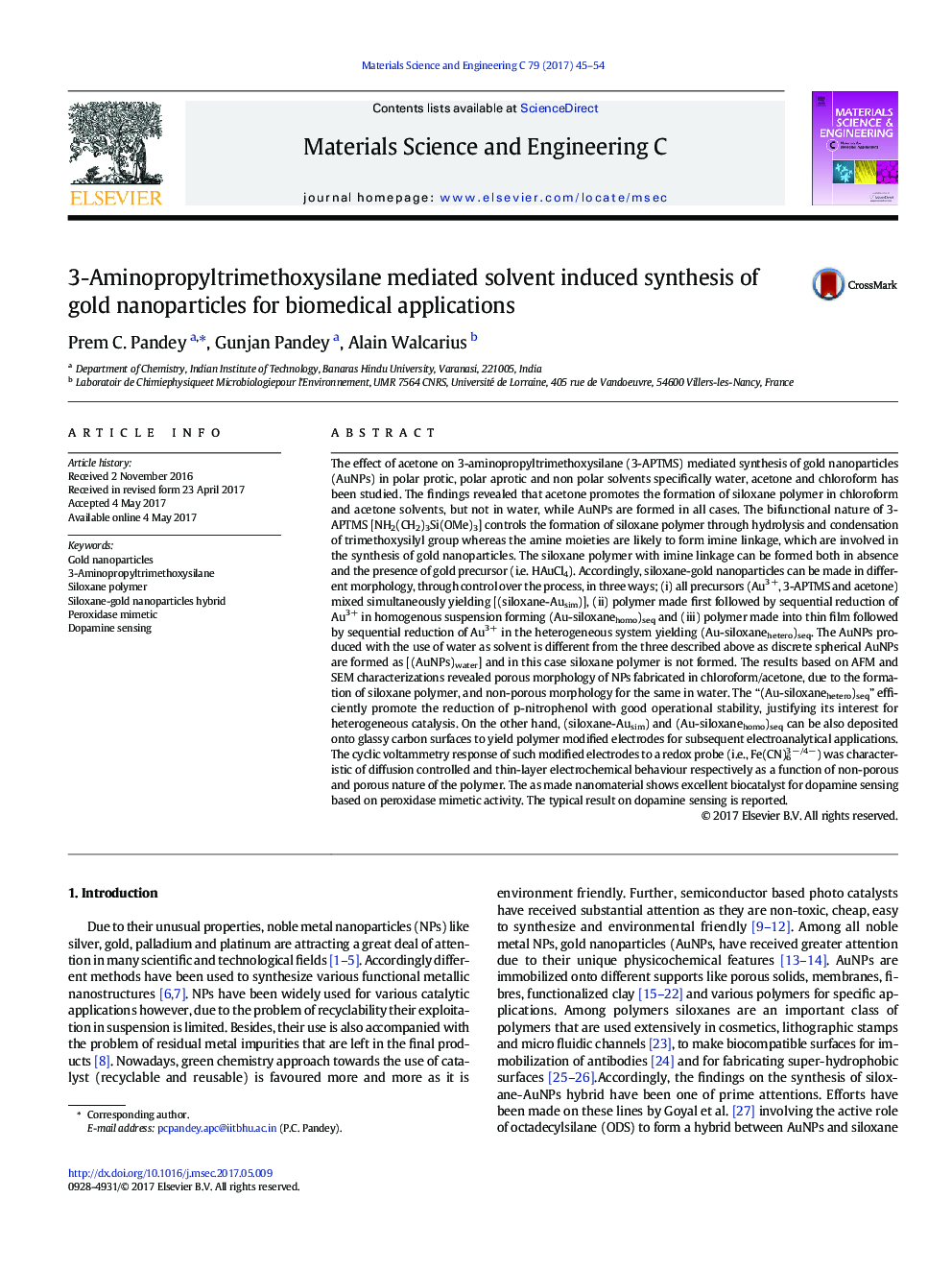| کد مقاله | کد نشریه | سال انتشار | مقاله انگلیسی | نسخه تمام متن |
|---|---|---|---|---|
| 5434702 | 1509142 | 2017 | 10 صفحه PDF | دانلود رایگان |
- Acetone promote 3-APTMS mediated synthesis of gold AuNPs in polar protic, polar aprotic and non polar solvents
- Siloxane polymer from 3-APTMS in chloroform and acetone solvents is formed, but not in water however AuNPs are formed in all cases.
- The siloxane polymer is soluble in acetone/chloroform.
- The siloxane polymer may be easily converted into thin film over suitable solid-surfaces.
- The siloxane polymer both in solution form and in thin film morphology enable AuNP synthesis justifying solid-state synthesis of AuNPs.
- Solvent dependent porous nature of polymer has been recorded for specific applications.
The effect of acetone on 3-aminopropyltrimethoxysilane (3-APTMS) mediated synthesis of gold nanoparticles (AuNPs) in polar protic, polar aprotic and non polar solvents specifically water, acetone and chloroform has been studied. The findings revealed that acetone promotes the formation of siloxane polymer in chloroform and acetone solvents, but not in water, while AuNPs are formed in all cases. The bifunctional nature of 3-APTMS [NH2(CH2)3Si(OMe)3] controls the formation of siloxane polymer through hydrolysis and condensation of trimethoxysilyl group whereas the amine moieties are likely to form imine linkage, which are involved in the synthesis of gold nanoparticles. The siloxane polymer with imine linkage can be formed both in absence and the presence of gold precursor (i.e. HAuCl4). Accordingly, siloxane-gold nanoparticles can be made in different morphology, through control over the process, in three ways; (i) all precursors (Au3+, 3-APTMS and acetone) mixed simultaneously yielding [(siloxane-Ausim)], (ii) polymer made first followed by sequential reduction of Au3+ in homogenous suspension forming (Au-siloxanehomo)seq and (iii) polymer made into thin film followed by sequential reduction of Au3+ in the heterogeneous system yielding (Au-siloxanehetero)seq. The AuNPs produced with the use of water as solvent is different from the three described above as discrete spherical AuNPs are formed as [(AuNPs)water] and in this case siloxane polymer is not formed. The results based on AFM and SEM characterizations revealed porous morphology of NPs fabricated in chloroform/acetone, due to the formation of siloxane polymer, and non-porous morphology for the same in water. The “(Au-siloxanehetero)seq” efficiently promote the reduction of p-nitrophenol with good operational stability, justifying its interest for heterogeneous catalysis. On the other hand, (siloxane-Ausim) and (Au-siloxanehomo)seq can be also deposited onto glassy carbon surfaces to yield polymer modified electrodes for subsequent electroanalytical applications. The cyclic voltammetry response of such modified electrodes to a redox probe (i.e., Fe(CN)63Â â/4Â â) was characteristic of diffusion controlled and thin-layer electrochemical behaviour respectively as a function of non-porous and porous nature of the polymer. The as made nanomaterial shows excellent biocatalyst for dopamine sensing based on peroxidase mimetic activity. The typical result on dopamine sensing is reported.
Journal: Materials Science and Engineering: C - Volume 79, 1 October 2017, Pages 45-54
